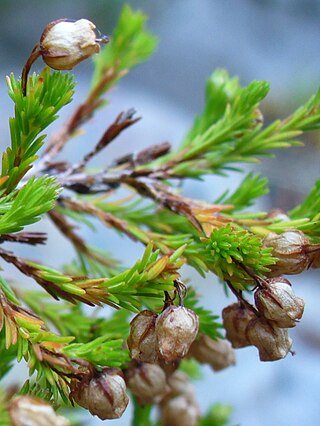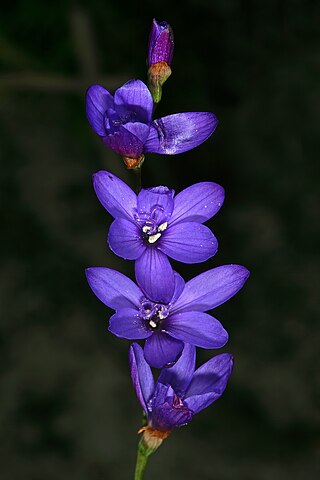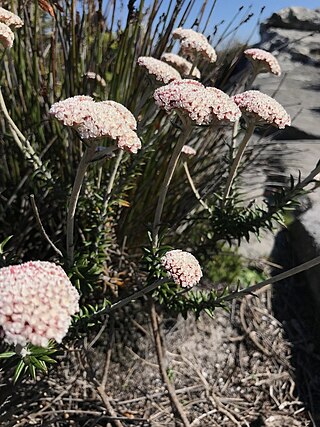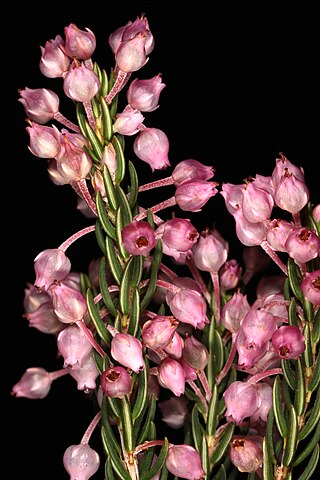
Erica is a genus of roughly 857 species of flowering plants in the family Ericaceae. The English common names heath and heather are shared by some closely related genera of similar appearance. The genus Calluna was formerly included in Erica – it differs in having even smaller scale-leaves, and the flower corolla consisting of separate petals. Erica is sometimes referred to as "winter heather" to distinguish it from Calluna "summer heather".

Freesia is a genus of herbaceous perennial flowering plants in the family Iridaceae, first described as a genus in 1866 by Christian Friedrich Ecklon (1886) and named after the German botanist and medical practitioner, Friedrich Freese (1795-1876). It is native to the eastern side of southern Africa, from Kenya south to South Africa, most species being found in Cape Provinces. Species of the former genus Anomatheca are now included in Freesia. The plants commonly known as "freesias", with fragrant funnel-shaped flowers, are cultivated hybrids of a number of Freesia species. Some other species are also grown as ornamental plants.

Kirstenbosch is an important botanical garden nestled at the eastern foot of Table Mountain in Cape Town. The garden is one of 10 National Botanical Gardens covering five of South Africa's six different biomes and administered by the South African National Biodiversity Institute (SANBI). Prior to 1 September 2004, the institute was known as the National Botanical Institute.

The orange-breasted sunbird is a species of small, predominantly nectar-feeding bird that is endemic to the fynbos shrubland biome of southwestern South Africa. It is the only member of the genus Anthobaphes, in the family Nectariniidae, though it is sometimes placed in the genus Nectarinia. The birds are sexually dimorphic, with females being olive green while the males are orange to yellow on the underside with bright green, blue and purple on the head and neck.

Erica abietina is a species of erica that is endemic to the Cape Peninsula of the Western Cape, South Africa. E. abietina includes four subspecies with often highly restricted distributions and distinctive flower colours. Previous delimitation of the species has included a further three subspecies which proved to be more distantly related to Cape Peninsula endemic E. abietina subspecies and are now classified under Erica grandiflora L.f. and Erica situshiemalis E.G.H.Oliv. & Pirie.

Erica baccans, the berry heath, is a species of Erica that was naturally restricted to the city of Cape Town, South Africa.

Erica margaritacea, the pearl heath, is a species Erica that was naturally restricted to the city of Cape Town. It is critically endangered.

Geissorhiza aspera, also known as the blue satin flower or blou sysie, is a geophyte from South Africa.

Cyrtanthus ventricosus, commonly called fire lilly, is a small deciduous, bulbous plant reaching a height of 100–250 mm (3.9–9.8 in). It is in the amaryllis family, Amaryllidaceae, and is found along the Cape Fold Mountains from the Cape Peninsula, Western Cape, to the Kouga Mountains, Eastern Cape in South Africa.
Plectranthus ambiguus, the pincushion spurflower, is a species of flowering plant in the family Lamiaceae, native to the Eastern Cape and Kwazulu-Natal provinces of South Africa. Its cultivar 'Manguzuku' has gained the Royal Horticultural Society's Award of Garden Merit. Flowers are pinkish purple with faint purple lines on the upper edge.

Protea venusta, the cascade sugarbush or creeping beauty, is a flower-bearing shrub belonging to the genus Protea. It is endemic to South Africa.
Lobostemon daltonii, the Infanta healthbush, is a species of the forget-me-not family endemic to South Africa.
Leucadendron loranthifolium, commonly known as the green-flower sunbush, is a flower-bearing shrub belonging to the genus Leucadendron and forms part of the fynbos. The plant is native to the Western Cape where it occurs in the Gifberg, Cederberg, Sandveld, and Hex River Mountains.

Serruria brownii, the bottlebrush spiderhead, is a flower-bearing shrub that belongs to the family Proteaceae and forms part of the fynbos. The plant is native to the Western Cape, South Africa.
Leucadendron gydoense, the Gydo conebush, is a flower-bearing shrub that belongs to the genus Leucadendron and forms part of the fynbos. The plant is native to the Western Cape, South Africa.

Erica caffra is a small tree, sometimes a shrub, that grows in riparian habitats and on forest edges and occurs from the Western Cape to the Drakensberg of KwaZulu-Natal and Lesotho. The tree's flowers look like bells. The tree's national tree number is 572.
Hymenolepis indivisa is a species of plant endemic to South Africa.

Anaxeton arborescens, the northern paperposy, is a species of plant from South Africa. It grows in the fynbos biome.

Erica irregularis, the Gansbaai heath, is a plant that belongs to the genus Erica and is part of the fynbos. This plan is native to the Western Cape and occurs from Stanford to Gansbaai. There are three known populations. The plant is extremely popular as cut flowers and this threatens its survival and there is no legislation to protect it. Also, the growth of the invasive plant, rooikrans, is a threat to the plant's habitat. Wildfires also pose a threat to the plant.

Heliophila africana, the African sunspurge or little blue mouth, is a species of plant from South Africa.















